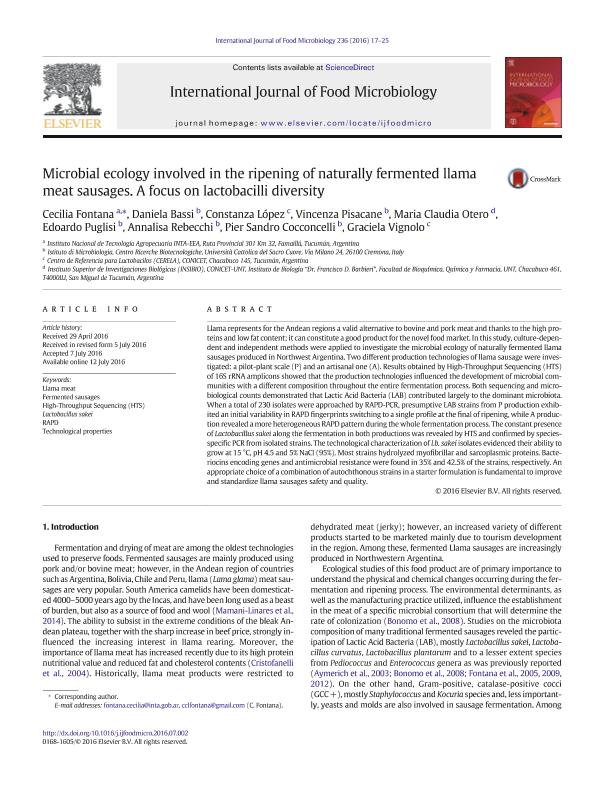Mostrar el registro sencillo del ítem
dc.contributor.author
Fontana, Cecilia Alejandra

dc.contributor.author
Bassi, Daniel
dc.contributor.author
López, Constanza María

dc.contributor.author
Pisacane, Vicenza
dc.contributor.author
Otero, María Claudia

dc.contributor.author
Puglisi, Edoardo
dc.contributor.author
Rebecchi, Annalisa
dc.contributor.author
Cocconcelli, Pier
dc.contributor.author
Vignolo, Graciela Margarita

dc.date.available
2017-12-12T16:56:16Z
dc.date.issued
2016-07-12
dc.identifier.citation
Fontana, Cecilia Alejandra; Bassi, Daniel; López, Constanza María; Pisacane, Vicenza; Otero, María Claudia; et al.; Microbial ecology involved in the ripening of naturally fermented llama meat sausages. A focus on lactobacilli diversity.; Elsevier Science; International Journal of Food Microbiology; 236; 12-7-2016; 17-25
dc.identifier.issn
0168-1605
dc.identifier.uri
http://hdl.handle.net/11336/30292
dc.description.abstract
Llama represents for the Andean regions a valid alternative to bovine and pork meat and thanks to the high proteins and low fat content; it can constitute a good product for the novel food market. In this study, culture-dependent and independent methods were applied to investigate the microbial ecology of naturally fermented llama
sausages produced in Northwest Argentina. Two different production technologies of llama sausage were investigated: a pilot-plant scale (P) and an artisanal one (A). Results obtained by High-Throughput Sequencing (HTS) of 16S rRNA amplicons showed that the production technologies influenced the development of microbial communities with a different composition throughout the entire fermentation process. Both sequencing and microbiological counts demonstrated that Lactic Acid Bacteria (LAB) contributed largely to the dominant microbiota.
When a total of 230 isolates were approached by RAPD-PCR, presumptive LAB strains from P production exhibited an initial variability in RAPD fingerprints switching to a single profile at the final of ripening, while A production revealed a more heterogeneous RAPD pattern during the whole fermentation process. The constant presence of Lactobacillus sakei along the fermentation in both productions was revealed by HTS and confirmed by speciesspecific PCR from isolated strains. The technological characterization of Lb. sakei isolates evidenced their ability to
grow at 15 °C, pH 4.5 and 5% NaCl (95%). Most strains hydrolyzed myofibrillar and sarcoplasmic proteins. Bacteriocins encoding genes and antimicrobial resistance were found in 35% and 42.5% of the strains, respectively. An appropriate choice of a combination of autochthonous strains in a starter formulation is fundamental to improve and standardize llama sausages safety and quality.
dc.format
application/pdf
dc.language.iso
eng
dc.publisher
Elsevier Science

dc.rights
info:eu-repo/semantics/openAccess
dc.rights.uri
https://creativecommons.org/licenses/by-nc-sa/2.5/ar/
dc.subject
Llama Meat
dc.subject
Fermented Sausages
dc.subject
High-Throughput Sequencing (Hts)
dc.subject
Lactobacillus Sakei
dc.subject
Rapd
dc.subject
Technological Properties
dc.title
Microbial ecology involved in the ripening of naturally fermented llama meat sausages. A focus on lactobacilli diversity.
dc.type
info:eu-repo/semantics/article
dc.type
info:ar-repo/semantics/artículo
dc.type
info:eu-repo/semantics/publishedVersion
dc.date.updated
2017-12-04T18:20:42Z
dc.identifier.eissn
1879-3460
dc.journal.volume
236
dc.journal.pagination
17-25
dc.journal.pais
Países Bajos

dc.journal.ciudad
Amsterdam
dc.description.fil
Fil: Fontana, Cecilia Alejandra. Instituto Nacional de Tecnología Agropecuaria. Centro Regional Tucuman-santiago del Estero. Estación Experimental Agropecuaria Famaillá; Argentina
dc.description.fil
Fil: Bassi, Daniel. Universita Cattolica del Sacro Cuore; Italia
dc.description.fil
Fil: López, Constanza María. Consejo Nacional de Investigaciones Científicas y Técnicas. Centro Científico Tecnológico Conicet - Tucuman. Centro de Referencia Para Lactobacilos; Argentina
dc.description.fil
Fil: Pisacane, Vicenza. Universita Cattolica del Sacro Cuore; Italia
dc.description.fil
Fil: Otero, María Claudia. Consejo Nacional de Investigaciones Científicas y Técnicas. Centro Científico Tecnológico Conicet - Tucumán. Instituto Superior de Investigaciones Biológicas. Universidad Nacional de Tucumán. Instituto Superior de Investigaciones Biológicas; Argentina
dc.description.fil
Fil: Puglisi, Edoardo. Universita Cattolica del Sacro Cuore; Italia
dc.description.fil
Fil: Rebecchi, Annalisa. Universita Cattolica del Sacro Cuore; Italia
dc.description.fil
Fil: Cocconcelli, Pier. Universita Cattolica del Sacro Cuore; Italia
dc.description.fil
Fil: Vignolo, Graciela Margarita. Consejo Nacional de Investigaciones Científicas y Técnicas. Centro Científico Tecnológico Conicet - Tucuman. Centro de Referencia Para Lactobacilos; Argentina
dc.journal.title
International Journal of Food Microbiology

dc.relation.alternativeid
info:eu-repo/semantics/altIdentifier/doi/http://dx.doi.org/10.1016/j.ijfoodmicro.2016.07.002
dc.relation.alternativeid
info:eu-repo/semantics/altIdentifier/url/http://sciencedirect.com/science/journal/01681605
Archivos asociados
